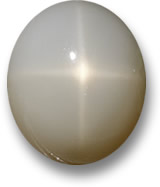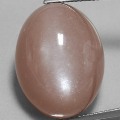Star Moonstone Gemstone Information and Education

Buy Star Moonstone Gemstones from GemSelect

About Star Moonstone - History and Introduction
Star moonstone is a gem-quality variety of orthoclase feldspar, a potassium aluminum silicate known as moonstone that shows a rare asterism effect under certain lighting. When you look at star moonstone, a four-rayed star seems to float across its surface. You get the best view under direct light, tilting and rotating the stone from various angles. Besides this unique asterism, star moonstone also displays adularescence - a milky sheen or wavy glowing light that appears to rise from below the surface. Check out our collection of star moonstone for sale if you're interested.
Moonstone gets its name from that almost magical, bluish-white shimmer resembling the moon's glow. This effect comes from alternating layers of orthoclase and albite, which interfere with light entering the stone. The light bounces back and scatters, creating a fantastic schiller. You'll often see this sheen in white, blue, or blue-orange hues, paired with the four-rayed star. Finding both adularescence and asterism in one stone is pretty rare, isn't it? Top-quality pieces can even show a 'three-dimensional' color thanks to moonstone's strong adularescence. Some unusual gems might display a cat's eye effect instead of asterism, known as cat's eye moonstone gem details. These are super rare and highly sought after.
Identifying Star Moonstone
Star moonstone stands out from other moonstone types due to its distinctive asterism. Made of potassium aluminum silicate, it's easy to spot because of its specific makeup. Unlike gems with similar shades, star moonstone has that captivating adularescence that helps identify it. A common way to tell it apart from other star gems is by testing hardness with a scratch; star moonstone usually sits between harder ones like star rose quartz and softer ones like star diopside. Plus, star moonstone features clear four-rayed stars forming near-perfect right angles, while star diopside's stars are wavy and don't cross at right angles. By comparison, star ruby and star sapphire have six-rayed stars.
Star Moonstone Origin and Gemstone Sources
Moonstone deposits often form in feldspar-rich granitic and syenitic pegmatites. Star moonstone is extremely rare and comes from the same mines as regular moonstone. The key deposits are in Sri Lanka. Other places producing star moonstone include Australia, Brazil, Germany, Myanmar (Burma), Madagascar, Mexico, Norway, Switzerland, and Tanzania. Right now, Sri Lanka produces a highly desirable blue-colored moonstone, and India leads in blue-sheen moonstone, also called rainbow moonstone gem information.
Buying Star Moonstone and Determining Star Moonstone Gemstone Value
Star Moonstone Color
Star moonstone is usually colorless, but it can appear in various colors. It often has a silvery sheen with base body colors like gray, mocha brown, yellow, orange, green, pink, blue, cream, and white. Pieces with blue sheen and white to colorless body are most desirable. Deep-blue stands out as the most valuable.
Star Moonstone Clarity and Luster
Star moonstone tends to be milky and translucent when held up to light. The transparent ones fetch higher prices. When cut and polished, it has an attractive vitreous luster. Specimens with centered, clear, and distinct stars are considered top value.
Star Moonstone Cut and Shape
Star moonstone is always cabochon-cut to highlight the asterism and adularescence. The cut's orientation matters a lot to bring out the sheen. Most are cut with high domes in oval shapes to keep as much weight from the rough as possible. Rounds and calibrated sizes are rare and can cost more.
Star Moonstone Treatment
Star moonstone isn't typically treated or enhanced, though some blue moonstones have been noted as color-boosted by coating.
Star Moonstone Gemological Properties
| Chemical Formula: | KalSi3O8, Potassium aluminum silicate |
| Crystal Structure: | Monoclinic, prismatic |
| Color: | Colorless, yellow, pale sheen |
| Hardness: | 6 to 6.5 on the Mohs scale |
| Refractive Index: | 1.518 to 1.526 |
| Density: | 2.56 to 2.59 |
| Cleavage: | Perfect |
| Transparency: | Transparent to translucent |
| Double Refraction or Birefringence: | -0.008 |
| Luster: | Vitreous to pearly |
| Fluorescence: | Weak; bluish, orange |
Please refer to our Gemstone Glossary for details of gemology-related terms.
Star Moonstone: Varieties or Similar Gemstones

Star moonstone belongs to the feldspar mineral group. Feldspars account for about 60% of Earth's crust, making them the most common mineral. Gem feldspars split into potassium feldspar and plagioclase feldspar. Star moonstone is a potassium feldspar, along with stones like amazonite and orthoclase.
'Rainbow moonstone' looks similar, but it's actually labradorite, a plagioclase feldspar, not potassium. Still, since both are feldspars, they're related. Sometimes 'rainbow moonstone' is called 'blue-sheen labradorite', which fits better as a name.
Most Popular Similar or Related Trade Names & Gemstones:
Moonstone gemstone properties and uses, cat's eye moonstone, rainbow moonstone, and sunstone are the most popular and well-known similar or related gemstones.
Lesser-Known Similar or Related Trade Names & Gemstones:
Orthoclase, amazonite, andesine, labradorite, andesine-labradorite, blue sheen labradorite, and oligoclase are lesser-known similar or related gemstones.
Star Moonstone Gemstone Mythology, Metaphysical and Alternative Crystal Healing Powers
Star moonstone carries the same legends, powers, and energy as other moonstone types. Few gems have as much lore as moonstone historical myths and stories. Hindu legend says it formed from moonbeams. In India, it's seen as sacred and thought to bring good fortune. In many Arab countries, women sew moonstone into undergarments as a fertility symbol.
In ancient Rome, moonstone was thought to come from moonlight drops. It was believed to hold lunar powers, tied to romance, dreams, emotion, femininity, intuition, and love. Lovers prize it for sparking tenderness and passion. Many cultures see moonstone as a great healing stone, easing pain from headaches and backaches. It also links to travelers, once called the "traveler's stone".
All moonstone varieties are official June birthstones and connect to Pisces zodiac sign.
| Disclaimer: Metaphysical and Alternative Crystal Healing Powers and Properties are not to be taken as confirmed advice. Traditional, Ceremonial and Mythological Gemstone Lore is collected from various resources and is not the sole opinion of SETT Co., Ltd. This information is not to replace the advice of your doctor. Should you have any medical conditions, please see a licensed medical practitioner. GemSelect does not guarantee any claims or statements of healing or astrological birthstone powers and cannot be held liable under any circumstances. |
Star Moonstone Gemstone and Jewelry Design Ideas
Star moonstone isn't as tough as many jewelry gems, but it's still popular for designs despite that.
Since it's always cabochon-cut, designs suit flat-bottomed settings. Wear it in protective pieces like pendants, earrings, pins, or brooches. It can make beautiful cabochon rings, but take care to avoid scratches and knocks because of its softness. Only wear such rings now and then. It's sensitive to pressure, so skip tension settings. Star gems appeal to both men and women. For guys, star moonstone works well in cuff-links and tie-tacks.
Note: Buy colored gemstones by size and not by carat weight. Colored stones vary in size-to-weight ratio. Some stones are larger and others are smaller than diamond by weight in comparison.
Star Moonstone Gemstone and Jewelry Care and Cleaning

Star moonstone isn't very durable, so it needs extra care, especially in jewelry. Skip harsh chemicals like bleach or acid, and avoid ultrasonic or steam cleaners. Just use mild soap and a soft cloth or brush. Rinse with warm to room-temperature water to clear soap.
It's pressure-sensitive, so steer clear of extreme temperature changes. Remove jewelry before sports, exercise, or chores. Store away from other gems to prevent scratches. Wrap each piece in soft cloth or use a fabric-lined box for protection.
Frequently Asked Questions
What is star moonstone?
Star moonstone is a variety of orthoclase feldspar that shows a rare four-rayed star effect under light, along with a milky sheen called adularescence.
How can I identify genuine star moonstone?
Look for its unique four-rayed asterism at right angles and adularescence. Hardness testing can help distinguish it from similar star gems.
Where does star moonstone come from?
Main sources include Sri Lanka, India, Australia, Brazil, and several other countries, with Sri Lanka known for blue varieties.
Is star moonstone treated?
Typically no, but some blue moonstones may have coatings for color enhancement.
How should I care for star moonstone jewelry?
Use mild soap and soft cloth for cleaning, avoid harsh chemicals, and store separately to prevent scratches.
What are the metaphysical properties of star moonstone?
It's linked to lunar energy, love, intuition, and healing, but remember, these claims are based on lore and not scientific evidence.

